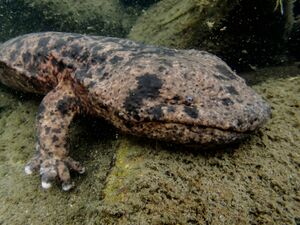Japanese giant salamander: Difference between revisions
Jump to navigation
Jump to search
| Line 35: | Line 35: | ||
== Conservation == | == Conservation == | ||
Due to the species being highly endemic, the biggest threat to the Japanese Giant Salamander is habitat loss. This is due to human activity damming up riverbeds and freshwater sources occupied by the Giant Salamander. Climate change is also a source for concern to the Japanese Giant Salamander due to estimated rainfall increasing leading to the destruction of streambeds.<ref>Ministry of the Environment, Ministry of Education, Culture, Sports, Science and Technology, Ministry of Agriculture, Forestry and Fisheries, Ministry of Land, Infrastructure, Transport and Tourism, & Japan Meteorological Agency (2018): Climate change in Japan and its impacts. – Synthesis Report on Observations, Projections and Impact Assessments of Climate Change, 2018.</ref> Other sources of threats are pollution and the introduction of invasive species into Japan specifically the Chinese Giant Salamander. <ref> {{Cite web|last=Matsui|first=Masafumi|date=2014|title=Confirmation of genetic pollution of alien Chinese giant salamander on native Japanese species (In Japanese)|url=https://kaken.nii.ac.jp/ja/file/KAKENHI-PROJECT-23510294/23510294seika.pdf|url-status=live}} Retrieved 05/9/2022 </ref> | Due to the species being highly endemic, the biggest threat to the Japanese Giant Salamander is habitat loss. This is due to human activity damming up riverbeds and freshwater sources occupied by the Giant Salamander. Climate change is also a source for concern to the Japanese Giant Salamander due to estimated rainfall increasing leading to the destruction of streambeds.<ref>Ministry of the Environment, Ministry of Education, Culture, Sports, Science and Technology, Ministry of Agriculture, Forestry and Fisheries, Ministry of Land, Infrastructure, Transport and Tourism, & Japan Meteorological Agency (2018): Climate change in Japan and its impacts. – Synthesis Report on Observations, Projections and Impact Assessments of Climate Change, 2018.</ref> Other sources of threats are pollution and the introduction of invasive species into Japan specifically the Chinese Giant Salamander.<ref>{{Cite web|last=Matsui|first=Masafumi|date=2014|title=Confirmation of genetic pollution of alien Chinese giant salamander on native Japanese species (In Japanese)|url=https://kaken.nii.ac.jp/ja/file/KAKENHI-PROJECT-23510294/23510294seika.pdf|url-status=live}} Retrieved 05/9/2022 </ref> | ||
== References == | == References == | ||
Revision as of 18:26, 10 May 2022

| |
| Kingdom: | Animalia |
|---|---|
| Phylum: | Chordata |
| Class: | Amphibia |
| Order: | Urodela |
| Family: | Cryptobranchidae |
| Genus: | Andrias |
| Species: | A. japonicus |
| Source: Integrated Taxonomic Information System[1] | |
Description
Diet
With the Japanese Giant Salamander living its entire life in the water the diet consists of freshwater fish, frogs, and crabs. Due to the slow metabolism of the salamander the species can go without eating for days.[2]
Behavior
Conservation
Due to the species being highly endemic, the biggest threat to the Japanese Giant Salamander is habitat loss. This is due to human activity damming up riverbeds and freshwater sources occupied by the Giant Salamander. Climate change is also a source for concern to the Japanese Giant Salamander due to estimated rainfall increasing leading to the destruction of streambeds.[3] Other sources of threats are pollution and the introduction of invasive species into Japan specifically the Chinese Giant Salamander.[4]
References
- ↑ "Integrated Taxonomic Information System - Report", ITIS USGS Open-File Report 2006-1195: Nomenclature", USGS, n.d.. Retrieved 5/9/2022.
- ↑ “Discover How Scientists Have Recreated the Benefits of Insects' Compound Eyes as Compound Lenses.” Encyclopædia Britannica, Encyclopædia Britannica, Inc., https://www.britannica.com/video/216533/Artificial-bug-eyes-could-lead-to-new-vision-systems. Retrieved 5/9/2022
- ↑ Ministry of the Environment, Ministry of Education, Culture, Sports, Science and Technology, Ministry of Agriculture, Forestry and Fisheries, Ministry of Land, Infrastructure, Transport and Tourism, & Japan Meteorological Agency (2018): Climate change in Japan and its impacts. – Synthesis Report on Observations, Projections and Impact Assessments of Climate Change, 2018.
- ↑ “Discover How Scientists Have Recreated the Benefits of Insects' Compound Eyes as Compound Lenses.” Encyclopædia Britannica, Encyclopædia Britannica, Inc., https://www.britannica.com/video/216533/Artificial-bug-eyes-could-lead-to-new-vision-systems. Retrieved 05/9/2022